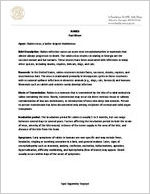RABIES Fact Sheet
Agent: Rabies virus, a bullet-shaped rhabdovirus
Brief Description: Rabies infection causes an acute viral encephalomyelitis in mammals that almost always progresses to death. The rabies virus strains circulating in Georgia are the raccoon variant and bat variants. These viruses have been associated with infections in many other species, including skunks, coyotes, bobcats, dogs, and cats.
Reservoir: In the United States, rabies reservoirs include foxes, raccoons, skunks, coyotes, and insectivorous bats. The virus is maintained primarily in intraspecies cycles in these reservoirs with occasional spillover infections in domestic animals (e.g., dogs, cats, livestock) and humans. Mammals such as rabbits and rodents rarely develop infection.
Mode of Transmission: Rabies is a zoonosis that is transmitted by the bite of a rabid animal via saliva containing the virus. Rarely, transmission may occur via direct nervous tissue or salivary contamination of mucous membranes, or introduction of virus into deep skin wounds. Person to person transmission has been documented only among recipients of corneal and solid organ transplants.
Incubation period: The incubation period for rabies is usually 1 to 3 months, but can range between several days to several years. Factors affecting the incubation period include the strain of virus, severity of the bite wound, richness of the nerve supply in the area of the bite, and distance of the bite from the brain.
Symptoms: Early symptoms of rabies in humans are non-specific and may include fever, headache, tingling or numbing sensation in a limb, and general malaise. Later, signs of encephalopathy such as insomnia, anxiety, confusion, excitation, hallucinations, agitation, hypersalivation, difficulty swallowing, and hydrophobia (fear of water) may appear. Death usually occurs within days of the onset of symptoms.
Equal Opportunity Employer
February 24, 2012 Page 2
Diagnostic Testing: A. Immunity after vaccine: Private laboratories can test human or domestic animal serum samples for rabies-neutralizing antibodies. Serology cannot be used to determine if a person has been exposed to rabies virus following a bite. B. Animal Rabies Diagnosis 1. Specimen: animal head or brain; whole bats 2. Form: Rabies Lab form #3062 3. Lab Test Performed: Direct Fluorescent Antibody (DFA) test 4. Lab performing test: Georgia Public Health Laboratory C. Human Rabies Diagnosis: 1. Specimen: nuchal biopsy, brain tissue, cerebrospinal fluid, serum, saliva 2. Lab Test Performed: Rapid Fluorescent Focus Inhibition Test (RFFIT), DFA, RT-PCR
The Epidemiology Branch (404-657-2588) MUST be consulted prior to collection of and submission of clinical specimens for human rabies diagnosis. Laboratory confirmation of human rabies infection is performed by the CDC Rabies Laboratory.
Laboratory Criteria for Diagnosis (ANIMALS): A positive direct fluorescent antibody test (performed on brain tissue)
Case Classification: Confirmed: a clinically compatible illness that is laboratory confirmed
Laboratory Criteria for Diagnosis (HUMANS): Detection by direct fluorescent antibody of viral antigens in a clinical specimen (preferably the brain or nerves surrounding hair follicles in the nape of the neck), Isolation (in cell culture or in a laboratory animal) of rabies virus from saliva, cerebrospinal fluid (CSF) or central nervous system tissue, Identification of a rabies-neutralizing antibody titer 5 (complete neutralization) in the serum or CSF, or Nested reverse transcription PCR methods to detect rabies virus RNA in saliva.
Period of Communicability: Rabies virus is present in the saliva and is potentially transmitted during the clinical period and perhaps several days before illness onset.
Treatment: Intensive supportive medical care is the only treatment.
February 24, 2012 Page 3
Pre-exposure prophylaxis: People at increased risk of rabies (i.e., rabies laboratory staff, veterinarians, animal handlers, wildlife officers, and people living in or traveling to areas where rabies is endemic) should receive rabies pre-exposure prophylaxis that includes a series of 3 vaccinations. Please see the Georgia Rabies Control Manual for more information.
Post-exposure prophylaxis (PEP): PEP consists of local wound treatment, passive antibody administration (HRIG), and a series of four vaccinations. The need for PEP should be based on risk assessment of the following areas: TYPE OF EXPOSURE, ANIMAL BEHAVIOR, ANIMAL SPECIES, LABORATORY TEST RESULTS, animal rabies vaccination history, and epidemiology of rabies in the area. Please see the Georgia Rabies Control Manual for more information.
Reporting: Report all suspect human and animal rabies cases IMMEDIATELY by phone to the local health department, District Health Office, or the Epidemiology Branch at 404-657-2588. If calling after regular business hours call the Epidemiology Branch answering service (770-578- 4104). After verbal report has been made, please transmit the case information electronically through the State Electronic Notifiable Disease Surveillance System (SENDSS) at http://sendss.state.ga.us or complete and mail a Georgia Notifiable Disease Report Form (#3095).
Reported Cases of Animal and Human Rabies in Georgia, 2000-2009
Number of Number of
Year
Animal
Human
Cases
Cases
2000
364
1
2001
402
0
2002
411
0
2003
402
0
2004
344
0
2005
256
0
2006
267
0
2007
301
0
2008
385
0
2009
404
0
References: 1. CDC. Compendium of Animal Rabies Control, 1999 National Association of State Public Health Veterinarians, Inc. MMWR 1999; 48(RR-3): 1-9
February 24, 2012 Page 4
2. CDC. Human Rabies Prevention United States, 2009 Recommendations of the Advisory Committee on Immunization Practices (ACIP). MMWR 2010; 59(02): 1-9.
3. CDC. Update: Raccoon Rabies Epizootic -- United States and Canada, 1999. MMWR 2000; 49(02): 31-5.
4. Chin J, ed. RABIES. In: Control of Communicable Diseases Manual. 17th ed. Washington, DC: American Public Health Association, 2000. 411-419.
Links: CDC Rabies http://www.cdc.gov/rabies/ WHO Rabies http://www.who.int/topics/rabies/en/ Georgia Poison Center http://www.georgiapoisoncenter.org/ Georgia Rabies Control Manual http://health.state.ga.us/pdfs/epi/zvbd/Rab_Man.pdf
